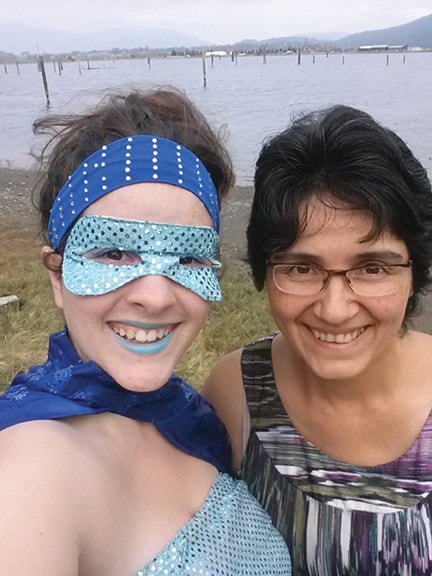Editor’s note: If you haven’t met “Flo” yet, this superhero is visiting Cowichan communities this summer, helping us face down a severe drought and water restrictions. Cowichan Watershed Board summer student Lauren Frost reports in weekly as Flo visits local watershed heroes to learn more about their work.
Name: Debra Toporowski
Occupation: Cowichan Tribes Councillor; Cowichan Watershed Board Member
Why Flo Likes Her: Water Quality/Estuarine Health Hero
Flo: Hi Debra. Thanks for making time to meet with me. Can you tell me a bit about your family and your connection to the Cowichan Valley?
Debra: My name is Qwulti’stunaat. My grandparents are the late Rosie Peter, and the late Stephen Jack from Quamichan. My mother is Ethel Jack and my father is Howard Wong. I’ve lived in the Cowichan Valley all my life, so I am well connected to the land.
Flo: I understand that through your participation as a Cowichan Watershed Board member, you are helping with the Board’s goal of being able to safely eat shellfish from Cowichan Bay again by 2020. Thank you for your work on that! What kind of things contribute to the health and edibility of the shellfish? Can you tell us about the history and importance of the clam harvest to Cowichan people?
Debra: The clam beds in Cowichan Bay used to be so productive that they fed Cowichan people through the winter. Historically shellfish have been extremely important to Cowichan people both as a source of nutrition but also socially and culturally. However since 1973 there has been a ban on clam harvesting because they are not safe to eat. Many factors have contributed to this situation such as sewage from vessels and float homes, the sewage outfall in the river and runoff from farmlands — particularly associated with poor manure management. All of those factors play a role in contaminating the water. The feasibility of relocating the sewage outflow is currently being looked at. That is a good step towards improving water quality.
Flo: There are clearly some significant water quality issues, and these are the reason our shellfish are unsafe to eat. What is the Watershed Board’s water sampling work indicating, and what is the Watershed Board doing to clean up the water?
Debra: The Watershed Board worked with the Ministry of Environment and a number of other partners to initiate three-year comprehensive water sampling in 2012. That project included DNA testing and found that some of the pollutants are bovine, meaning from cow manure. Others are human, and based on the sampling locations, those seem to be associated with marinas and float homes. As a result of that project the Watershed Board has worked with a number of our local farmers to develop a plan to stop manure and other pollutants from running into the streams and rivers. The goal was to get 12 farmers on board with moving this initiative forward. In addition the CVRD has been working on a marine bylaw to help address some of the human sources of pollution.
Flo: Being able to eat the shellfish in five years is a wonderful but challenging goal. Do you think you’ll get there?
Debra: It’s a wonderful dream. It will take a lot of hard work to get there. The solutions are there, we just have to make them happen.
Flo: Any last thoughts?
Debra: Our Cowichan River is a Heritage River. People take it for granted every day. But only when it’s gone, or polluted, will people be up in arms saying, “how did this happen?” That is what the Watershed Board and Cowichan Tribes are trying to point out. Working together we can do amazing things but we need to start today.
